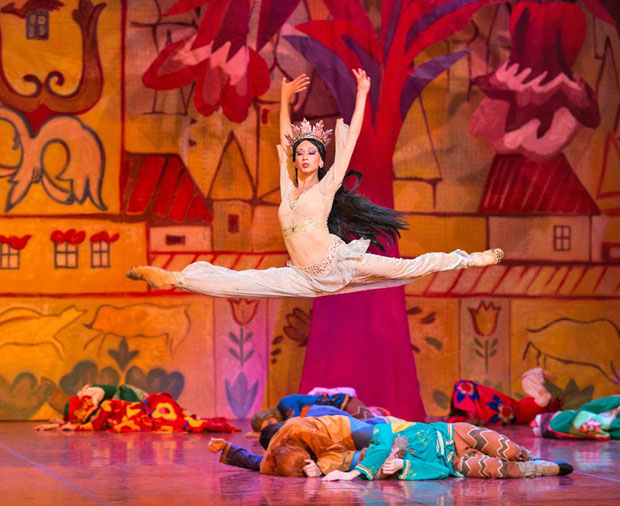
© Foteini Christofilopoulou. (Click image for larger version)
Les Saisons Russes of XXI Century with Natalia Sats Moscow State Music Theatre for Young Audiences
Diaghilev Festival: Le Coq d’Or (The Golden Cockerel)
London, Coliseum
8 July 2014
Interview with Andris Liepa and Georgy Isaakyan about the Diaghilev Festival and Le Coq d’Or
Gallery of Pictures by Foteini Christofilopoulou
www.liepa.ru
Coliseum website: www.eno.org
When Le Coq d’or (anglicised as The Golden Cockerel) was first performed at the Theatre Royal, Drury Lane, by Diaghilev’s Ballet Russe company in 1914, it was described in The Sunday Times as having ‘a child-like zest for romp and grotesquery’. The unnamed reviewer continued: ‘Unless you are too superior for nursery fun, you will surrender yourself wholeheartedly’.

© Foteini Christofilopoulou. (Click image for larger version)
A century later, that production has been re-imagined for the Natalia Sats Moscow State Music Theatre for Young Audiences. Andris Liepa, its co-producer with Georgiy Isaakyan, the company’s director, has brought it to the Coliseum for the enjoyment of audiences of all ages. (Interview with Liepa and Isaakyan about the season)
Rimsky-Korsakov’s fairy tale opera is sung on stage, with the choir of the Natalia Sats opera company seated in serried ranks on either side, as in the 1913-1914 production. They wear white costumes instead of red, which apparently made the originals look like Chelsea Pensioners. The principal singers, wearing evening dress, are set apart, making clear the double-casting of their roles with dancers in folkloric costumes based on designs by Natalia Goncharova. The brilliantly colourful sets are simulations of her 1913 décor, redesigned by Vyacheslav Okunev.
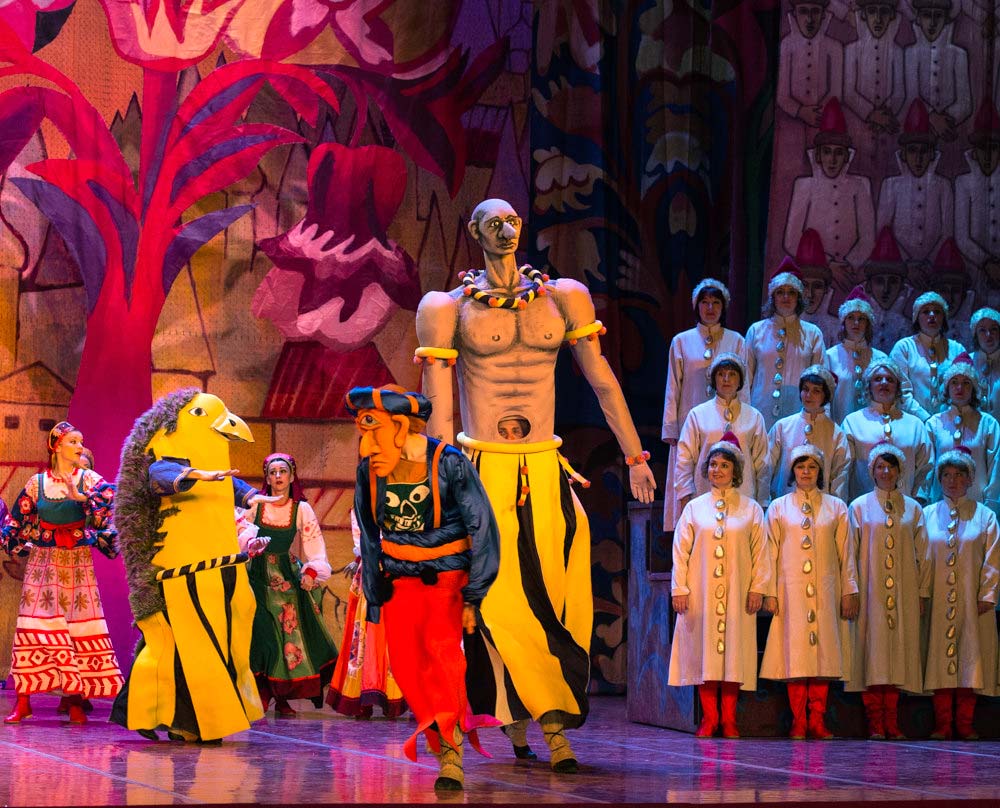
© Foteini Christofilopoulou. (Click image for larger version)
Since Mikhail Fokine’s choreography for various Ballets Russes productions of Le Coq d’or has largely been lost, Gali Abaidulov was commissioned to choreograph all three acts in the style of Fokine. He has certainly recreated the ‘romp and grotesquery’ that delighted the Theatre Royal reviewer. The action, vividly cartoonish, is performed with enthusiasm by members of the Natalia Sats ballet company, corps and principals.
The story, based on a poetic tale by Pushkin, has elements of The Firebird and Schéhérazade. King Dodon, a silly old ruler of an imaginary realm, wants to retire to a life of fun and sleep. To protect his kingdom from invasion, he is given a magical golden cockerel by an astrologer. The bird will warn of impending danger, which soon occurs. The king’s two inept sons are killed in battle, but instead of mourning them, Dodon falls for the seductive Queen of Shemakha, a mysterious oriental femme fatale. (The role was Tamara Karsavina’s favourite.)
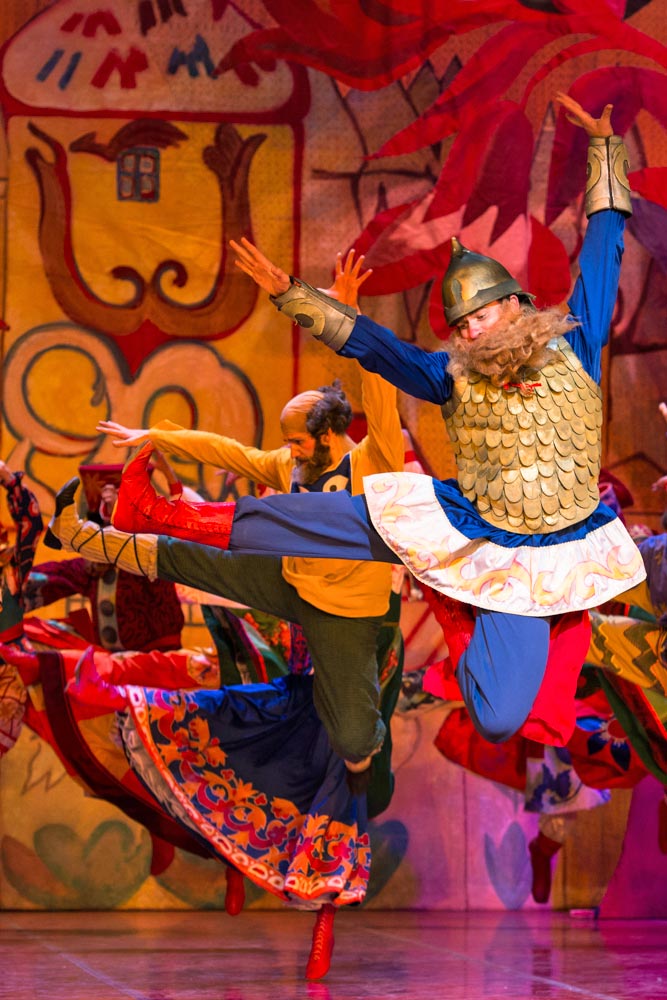
© Foteini Christofilopoulou. (Click image for larger version)
The king brings her as his bride to the capital, amidst general rejoicing. But when the astrologer reminds Dodon of his promise to give him anything in return for the invaluable cockerel, the king refuses. The astrologer wants the beautiful queen as his prize. Dodon kills him in a fit of rage and is pecked to death by the cockerel. The queen vanishes, the astrologer comes back to life and tells the audience it was only a fable. The implicit moral, however, is that it is unwise to trust arrogant, power-crazed figures of authority. Dodon’s subjects sing naively of their faith in their infallible tsar – ‘How will we live without him?’ they cry at the end. Aware of the political implications, Tsar Nicholas 11’s palace officials kept Le Coq d’or off the stage while Rimsky-Korsakov was still alive. Putin’s followers have left this revival alone, presumably as a harmless fairy tale for young people.

© Foteini Christofilopoulou. (Click image for larger version)
The production is indeed fabulous, resembling illustrations of Goncharova’s splendiferous designs. Diaghilev’s 1913 version must have looked and sounded much like this. Abaidulov’s choreography for galumphing boyars, clowns and peasants is similar to Fokine’s for Koshchei the magicians’s creatures in The Firebird; the oriental dances for the Queen of Shemakha’s retinue evoke the harem in Schéhérazade. Bumbling old King Dodon (Oleg Fomin), unlike the foolish eunuch in charge of the harem, is given vigorous leaps despite his age. The Golden Cockerel, Pavel Okunev, hurtles across the stage in virtuoso flying steps, his ‘kikirikiree’ crow sounded by the orchestra and soprano Zarina Samadova. Okunev’s Cockerel is impressively magical, small and discreet until he flares into life, golden wings flailing.
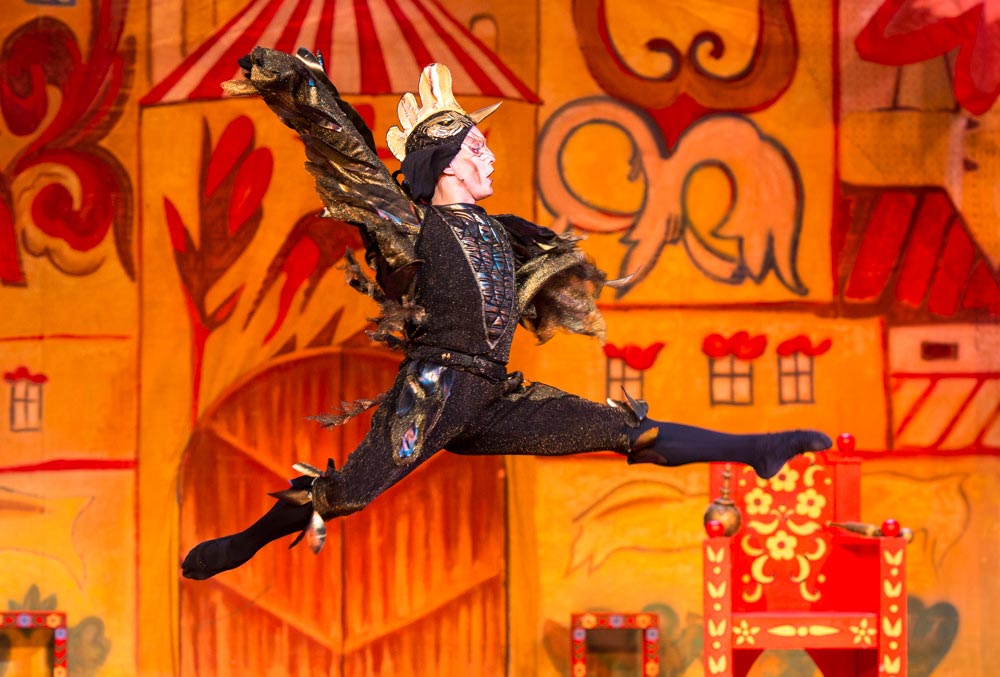
© Foteini Christofilopoulou. (Click image for larger version)
The diva role is that of the Queen, glamorously embodied by Natalia Savelieva in body-hugging white, once she removes her enveloping veil. As Cyril Beaumont wrote admiringly about Karsavina’s performance: ‘Those sinuous arms with their languorous movements could strangle as well as caress’. The character is a wicked one, either in cahoots with the Astrologer, like Odile with Von Rothbart, or a chimera. The soprano, Olesya Titenko, is similarly gorgeous, singing the Queen’s aria, her hymn to the sun, enthrallingly.

© Foteini Christofilopoulou. (Click image for larger version)
The principal singers are as much of a pleasure to look at as the dancers, since they are totally immersed in their roles. Thank goodness for surtitles, so that non-Russian-speakers can follow their words. The singers’ commitment and glorious voices are an ideal introduction to Rimsky-Korsakov’s opera. Acted out by the dancers, The Golden Cockerel is a somewhat ponderous experience, at two hours rather too long for ‘nursery fun’ (though the Queen’s performance by singer and dancer has nothing to do with the nursery). But it’s very Russian in its mixture of comedy, satire and luscious spectacle – and first-class performances.













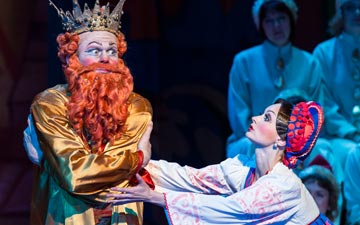



You must be logged in to post a comment.